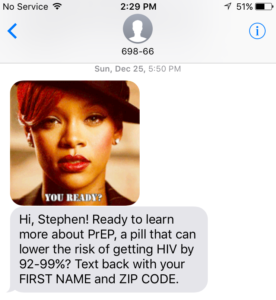
Problem: How do you provide a vulnerable population with access to a life-saving drug?
PrEP, a prescription medicine that can help reduce the risk of HIV transmission, has the potential to save lives. But many of the people most at risk face barriers when attempting to access the medication. They often are not aware that there are programs in place to help.
That’s especially true among young and minority populations. African Americans account for 44% of new HIV infections, but only 10% of them seek access to PrEP.
“On the one hand, we saw at-risk communities that weren’t accessing the medication,” said Storm Hurwitz, Health Campaigns Specialist for The New York State LGBT Health & Human Services Network (The Network). “And on the other, we saw the barriers those communities were facing.” The Network is administered by The Lesbian, Gay, Bisexual & Transgender Community Center (The Center).
Through a study conducted by the Strength in Numbers Consulting Group, The Center discovered that the chief barriers to accessing PrEP in New York were cost, drug-to-drug interaction (how PrEP might react with other medications or recreational drugs), and eligibility. People who needed the drug most did not even know if they could access it.
The Network, a coalition of 51 New York LGBT organizations and agencies, came together to find a solution.

Solution: An SMS program to provide information and inspiration
The Network launched a text message program to provide people the information they needed – and the inspiration to take the next step in their journey towards maintaining control over their sexual health.
“The main thing that drove our decision to use SMS was the research behind it,” said Hurwitz. “Clinical trials show increased medication adherence and appointment adherence. And then on the population-specific side, Pew Research did a study that found that people of color are more likely to use their phones to search for health-related information.”
Confronting Barriers
The Network focuses on directly addressing the specific barriers that subscribers face. For example, those subscribers who are concerned about the cost of PrEP will receive messages explaining how different programs cover access specific to their insurance situation. Subscribers who are concerned about drug-drug interaction will receive messages reassuring them that, for example, PrEP doesn’t interact with hormones or alcohol, and advising them to speak further with a doctor.
To provide this specific messaging, The Network makes use of Mobile Commons Smart Campaigns. Smart Campaigns allow messaging to groups of people without a specific opt-in keyword. By using smart campaigns, The Network can group all the people who are concerned about Costs into one flow, so that they only receive messages appropriate for their concerns.
Gif Messages
Real-talk about sexual health is important – but it’s a lot more eye catching when accompanied by a Rihanna gif. The program has made ample use of gif messages to help draw attention to their informational content.

Hurwitz decided to use gif messaging when he thought about the very real challenges that were being faced by the program’s subscribers.
“If someone is asking to learn about these barriers, that means they’re facing them,” he said. “I wanted to do more than just reply with words. I wanted to send playful motivation.”
Zip Code Locator
In addition to helping clear up myths and misinformation, the program’s goal is to connect participants with PrEP providers. So subscribers are asked to text in their zip code, and they then receive the contact information for the 3 PrEP providers nearest them.
Results: Connecting people with healthcare providers
So far, around 90% of the participants have said the campaign was helpful. Perhaps most importantly, many have let The Network know that they saw a provider. The campaign helped people overcome the barriers they faced, and find care from health professionals.
The SMS campaign also is proving to be a treasure trove of new data for HIV activists, providing a feedback loop where member organizations can learn region-specific information. For example, if the program sees that a majority of people from, hypothetically, upstate New York are asking questions about cost, then on-the-ground activists can adjust their outreach accordingly.
Ultimately, the program is just one step in helping people stay healthy. But it’s a vital step that’s showing real results.

